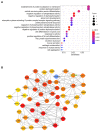Plasma Exosomal S1PR5 and CARNS1 as Potential Non-invasive Screening Biomarkers of Coronary Heart Disease
- PMID: 35837598
- PMCID: PMC9273894
- DOI: 10.3389/fcvm.2022.845673
Plasma Exosomal S1PR5 and CARNS1 as Potential Non-invasive Screening Biomarkers of Coronary Heart Disease
Abstract
Background: Early diagnosis and treatment significantly improve the prognosis of coronary heart disease (CHD), but no convenient screening tools are available. This study aims to find potential non-invasive screening biomarkers of coronary heart disease.
Method: We performed microarray analysis to investigate the mRNA expression levels in Small extracellular vesicles (sEVs) and screen significantly differentially expressed mRNAs in CHD patients vs. non-CHD patients. We then performed quantitative real-time polymerase chain reaction (qRT-PCR) to validate the microarray results, and we calculated the correlations between expression levels and clinicopathological data. Microarray analysis identified 72 downregulated mRNAs and 31 upregulated mRNAs in CHD patients relative to non-CHD patients.
Results: From the study, we found that upregulated sphingosine-1-phosphate receptor 5 (S1PR5) and downregulated carnosine synthase 1 (CARNS1) had the most significant differences between the patient group and the control group. S1PR5 expression was correlated with diabetes, heart rate, triglycerides, total cholesterol, low-density lipoprotein cholesterol, apolipoprotein B, and fasting blood glucose (P < 0.05). CARNS1 level was correlated with uric acid (UA) (P < 0.05). Overexpressed S1PR5 and downregulated CARNS1 were independent risk factors for CHD. The area under the receiver operating characteristic curve (AUC) of S1PR5 was 0.838 for diagnosing CHD; the AUC of CARNS1 was 0.883 for non-CHD; and the AUC of S1PR5 plus CARNS1 was 0.921 for CHD.
Conclusions: Microarray analysis showed that upregulated S1PR5 and downregulated CARNS1 in sEVs have the potential to become non-invasive biomarkers for CHD screening.
Keywords: coronary heart disease; genomics; lipid metabolism; mRNA; sEVs.
Copyright © 2022 Xiong, Mao, Zhao, Zhang, Tan, Liu, Wang, Xu, Li and Zhang.
Conflict of interest statement
The authors declare that the research was conducted in the absence of any commercial or financial relationships that could be construed as a potential conflict of interest.
Figures




Similar articles
-
Correlation of Long Non-coding RNA LncRNA-FA2H-2 With Inflammatory Markers in the Peripheral Blood of Patients With Coronary Heart Disease.Front Cardiovasc Med. 2021 Jun 21;8:682959. doi: 10.3389/fcvm.2021.682959. eCollection 2021. Front Cardiovasc Med. 2021. PMID: 34235188 Free PMC article.
-
[Relationship between serum levels of osteoproteins, inflammatory cytokines and coronary heart disease and disease severity].Zhonghua Wei Zhong Bing Ji Jiu Yi Xue. 2019 May;31(5):588-593. doi: 10.3760/cma.j.issn.2095-4352.2019.05.013. Zhonghua Wei Zhong Bing Ji Jiu Yi Xue. 2019. PMID: 31198145 Chinese.
-
Combining bioinformatics analysis and experiments to explore CARNS1 as a prognostic biomarker for breast cancer.Mol Genet Genomic Med. 2021 Feb;9(2):e1586. doi: 10.1002/mgg3.1586. Epub 2021 Feb 3. Mol Genet Genomic Med. 2021. PMID: 33533160 Free PMC article.
-
Increased alpha-defensin expression is associated with risk of coronary heart disease: a feasible predictive inflammatory biomarker of coronary heart disease in hyperlipidemia patients.Lipids Health Dis. 2016 Jul 18;15:117. doi: 10.1186/s12944-016-0285-5. Lipids Health Dis. 2016. PMID: 27430968 Free PMC article.
-
Combined use of apolipoprotein B/apolipoprotein A1 ratio and non-high-density lipoprotein cholesterol before routine clinical lipid measurement in predicting coronary heart disease.Coron Artery Dis. 2014 Aug;25(5):433-8. doi: 10.1097/MCA.0000000000000100. Coron Artery Dis. 2014. PMID: 24608795
Cited by
-
Exosomes in Cardiovascular Disease: From Mechanism to Therapeutic Target.Metabolites. 2023 Mar 27;13(4):479. doi: 10.3390/metabo13040479. Metabolites. 2023. PMID: 37110138 Free PMC article. Review.
-
Clinical Value of the Diagonal Earlobe Crease in Patients with Chest Pain for Diagnosing Coronary Heart Disease.Int J Gen Med. 2024 Apr 23;17:1557-1569. doi: 10.2147/IJGM.S454888. eCollection 2024. Int J Gen Med. 2024. PMID: 38680192 Free PMC article.
-
Sphingolipid metabolites involved in the pathogenesis of atherosclerosis: perspectives on sphingolipids in atherosclerosis.Cell Mol Biol Lett. 2025 Feb 7;30(1):18. doi: 10.1186/s11658-024-00679-2. Cell Mol Biol Lett. 2025. PMID: 39920588 Free PMC article. Review.
-
Engineering extracellular vesicles for targeted therapeutics in cardiovascular disease.Front Cardiovasc Med. 2024 Dec 19;11:1503830. doi: 10.3389/fcvm.2024.1503830. eCollection 2024. Front Cardiovasc Med. 2024. PMID: 39749310 Free PMC article. Review.
-
Emerging role of exosomes in vascular diseases.Front Cardiovasc Med. 2023 Mar 2;10:1090909. doi: 10.3389/fcvm.2023.1090909. eCollection 2023. Front Cardiovasc Med. 2023. PMID: 36937921 Free PMC article. Review.
References
LinkOut - more resources
Full Text Sources
Other Literature Sources
Molecular Biology Databases

